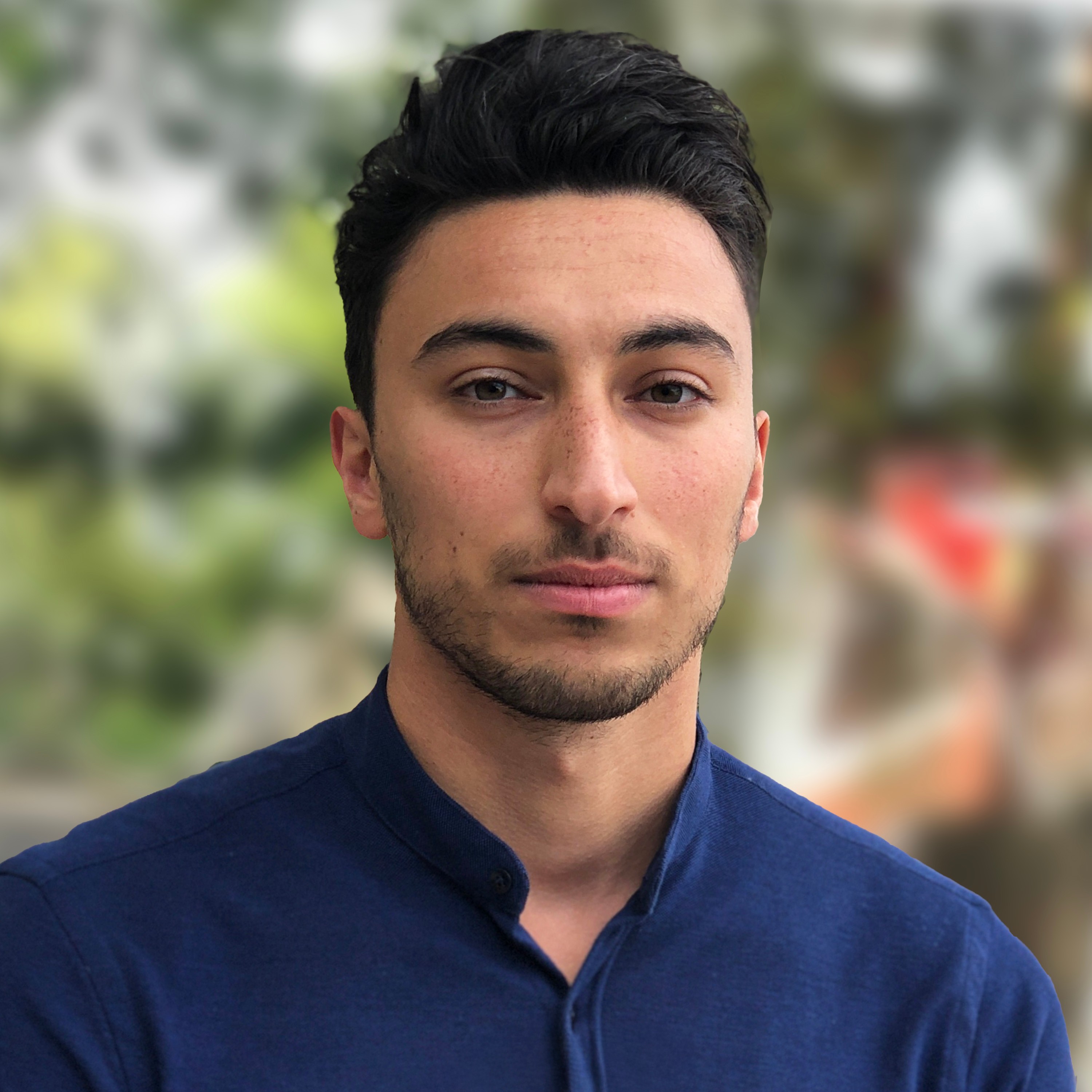Aytac
.design
Q2 2023 - Q2 2024
Transforming Internal Tooling for Thousands of Agents
Reducing handling time by 70% and creating a scalable UX foundation at VodafoneZiggo
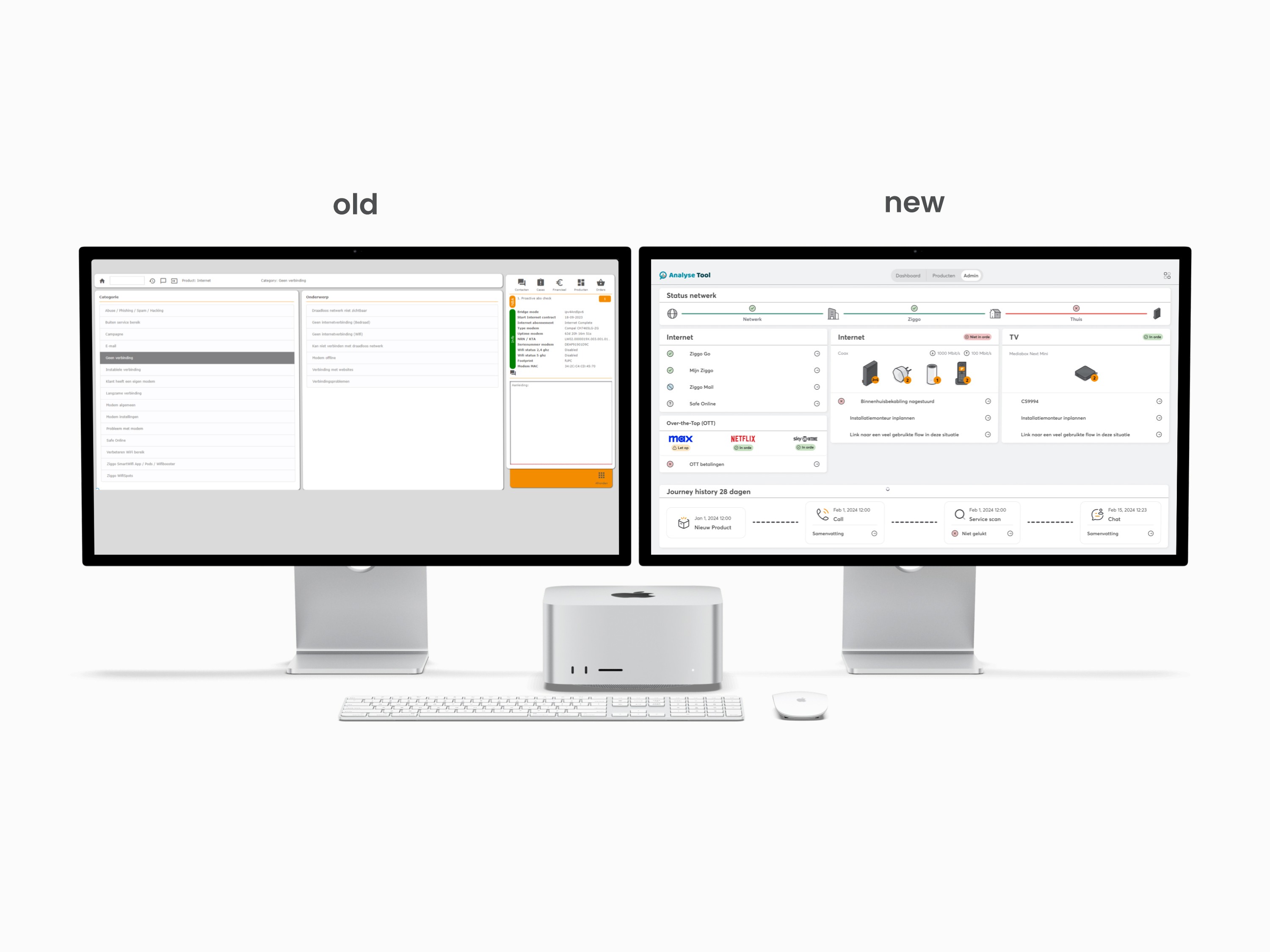
Project Overview
At VodafoneZiggo, we redesigned the internal tool used by customer service agents, replacing an outdated legacy system (ADT) with a smart, user-centered platform that drastically improved efficiency, user satisfaction, and service quality.
The project goal: streamline workflows, reduce call handling time, and boost agent experience, ultimately impacting KPIs tied to operational cost and NPS.
My Role
As Lead UX Designer, I owned the full process from discovery to final delivery, working in close collaboration with developers, data engineers, and product leadership.
I combined my background in software engineering and UX to:
- Translate technical API capabilities into smart UI flows
- Lead co-creation with users and stakeholders
- Align business, user, and technical needs
The Challenge
Agents were using the outdated tool:
- Required ~30–50 clicks to resolve common issues
- No smart data integration despite available APIs
- Cluttered, non-accessible UI
- Long average call durations
- Poor agent morale and high training overhead
This inefficiency was costing the business in longer calls, lower CSAT/NPS, and higher support costs.
“In the old version, it took me 45 minutes. In the new one, just 5. I finally feel like I can focus on the customer again.”

Teun de Vries
SR Advisor OEC
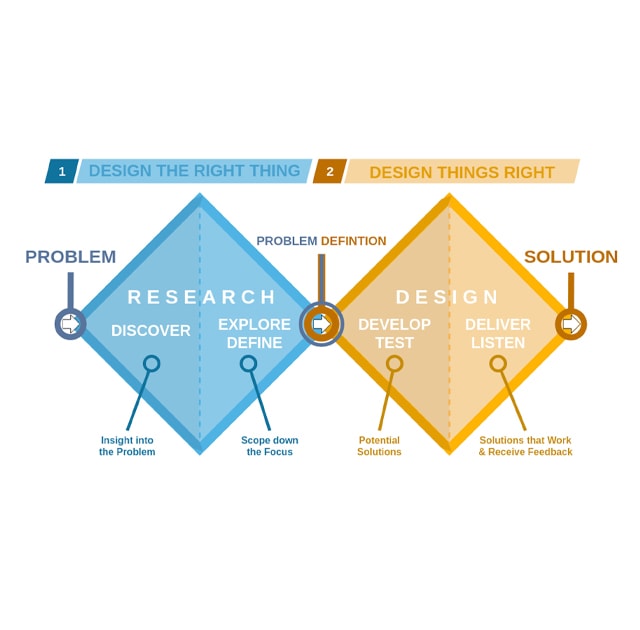
Discovery & Research
I followed the Double Diamond and Design Thinking methods:
- Shadowed agents during live customer calls
- Conducted qualitative interviews to map pain points and desired improvements
- Performed the agent role myself for deeper empathy
- Synthesized insights into opportunity areas for automation, decision support, and layout simplification

Co-Creation & Ideation
I ran a series of design workshops with:
- Agents, to co-create ideas and highlight workflow needs
- Developers and data engineers, to explore feasibility
- Product Owners and Service Designers, to ensure alignment with roadmap and strategy
I facilitated prioritization sessions to scope features into an MVP and balance impact vs. effort.
I ran a series of design workshops with:
- Agents, to co-create ideas and highlight workflow needs
- Developers and data engineers, to explore feasibility
- Product Owners and Service Designers, to ensure alignment with roadmap and strategy
I facilitated prioritization sessions to scope features into an MVP and balance impact vs. effort.
“Test often test early.”
Wireframing
In the early concept phase, I began testing ideas through low-fidelity wireframes to map out the core user flows. These helped identify early friction points and align with stakeholders.
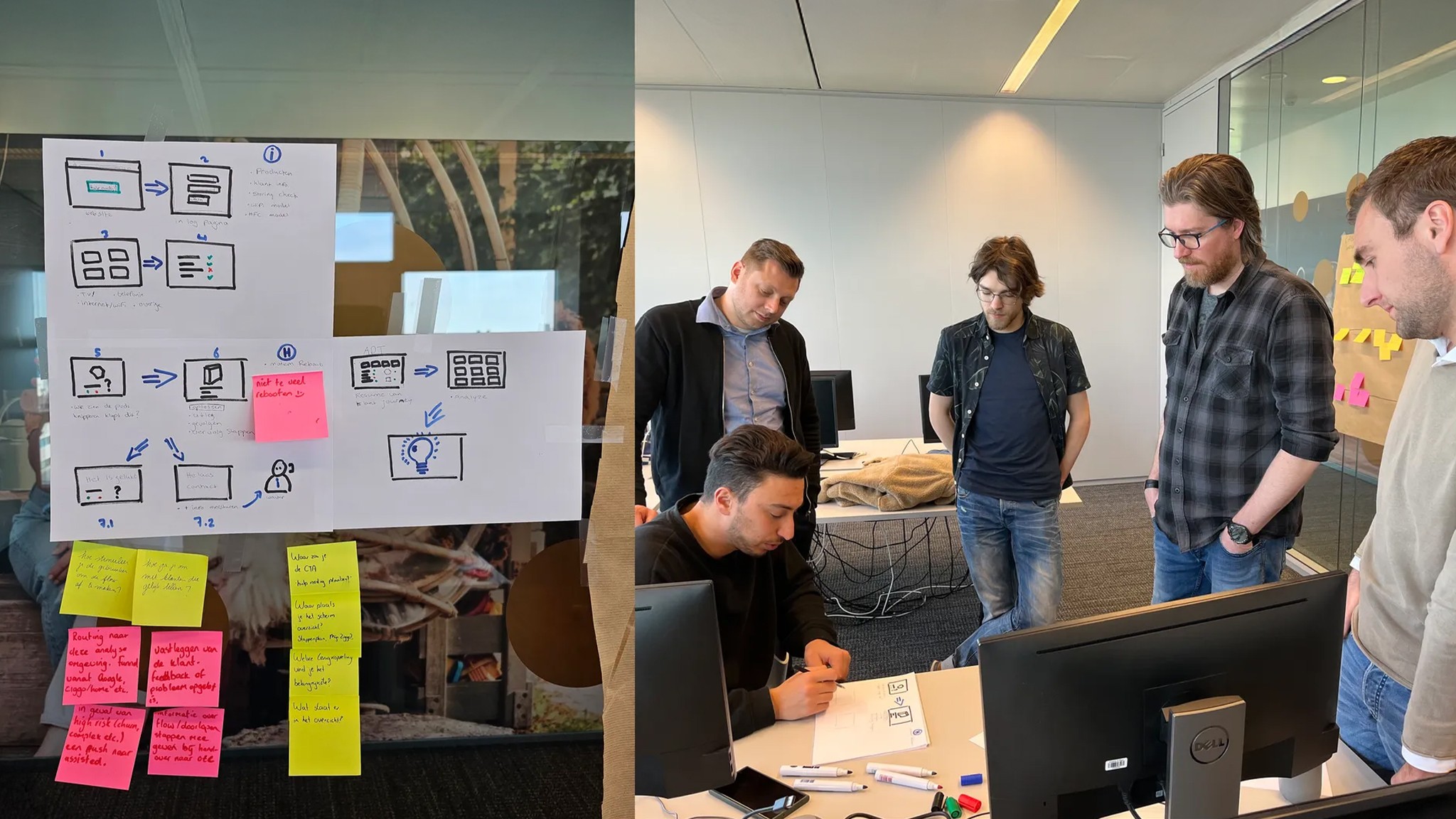
Paper Prototypes
I also created paper prototypes. This allowed agents and team members to interact with and critique the structure before any digital design was produced.
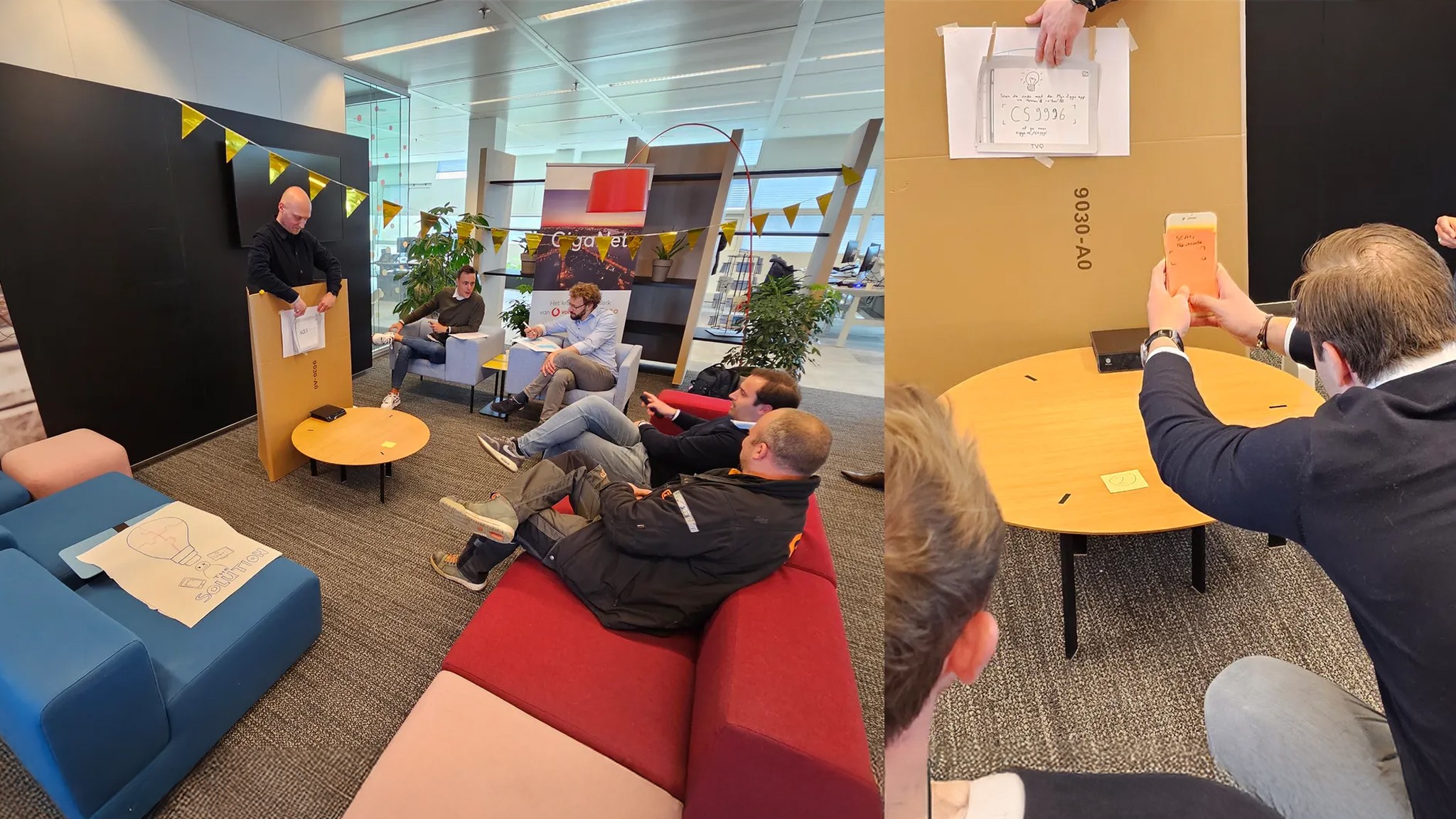
Low-Fidelity Design
Based on the findings from the paper prototypes and co-creation workshops, I translated validated ideas into low-fidelity designs in Figma.

Design Execution
Develop & Deliver
Modular, data-driven UI
- Created smart flows that react to real-time API data
- Reduced redundant inputs and manual searches
- Designed components to match service types dynamically
Prototyping & Testing
- Built interactive prototypes in Figma with conditional logic, micro-animations, and realistic flows
- Ran usability tests with 10+ agents, timing completion vs. old tool
- Iterated based on feedback loops after each sprint
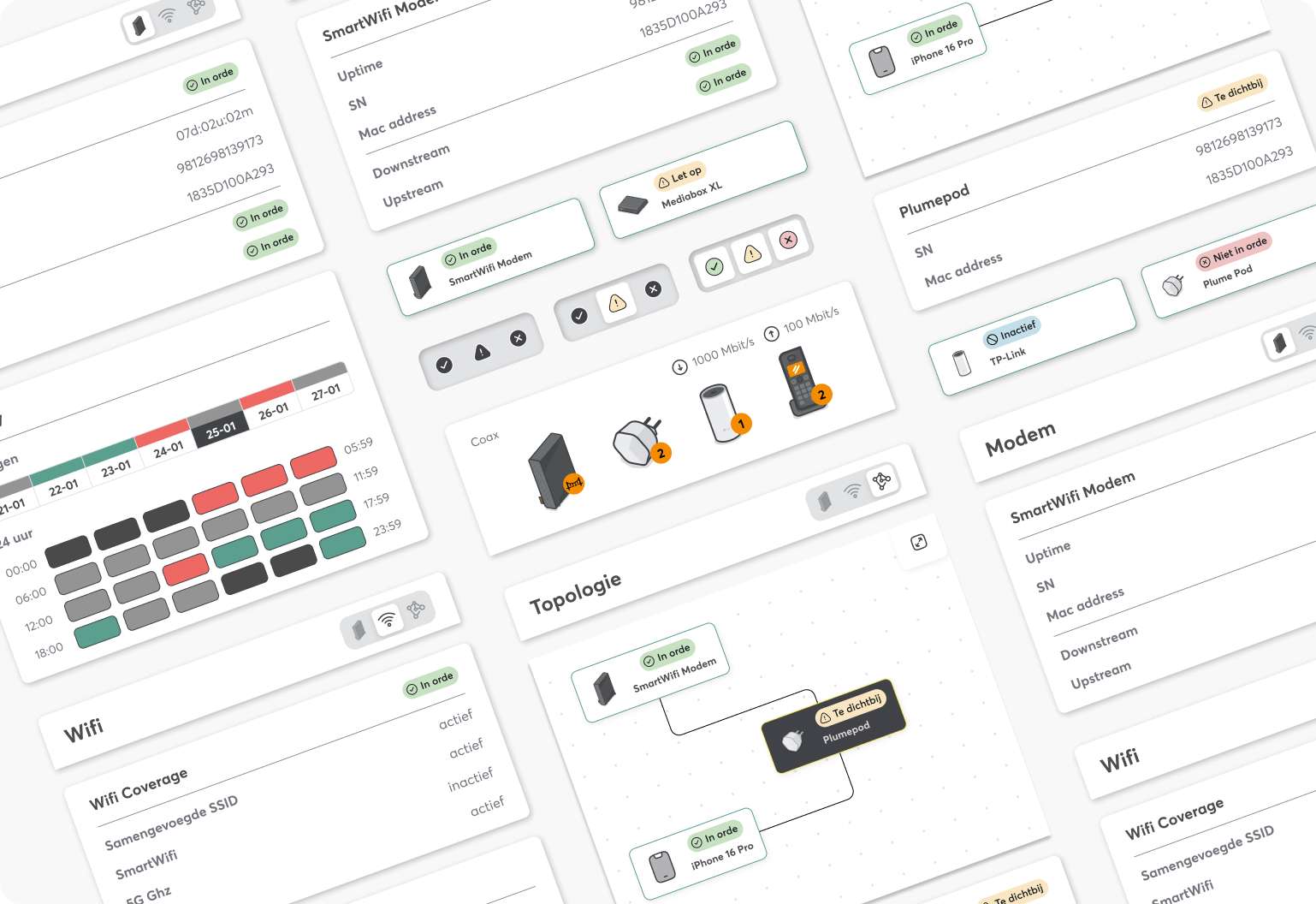
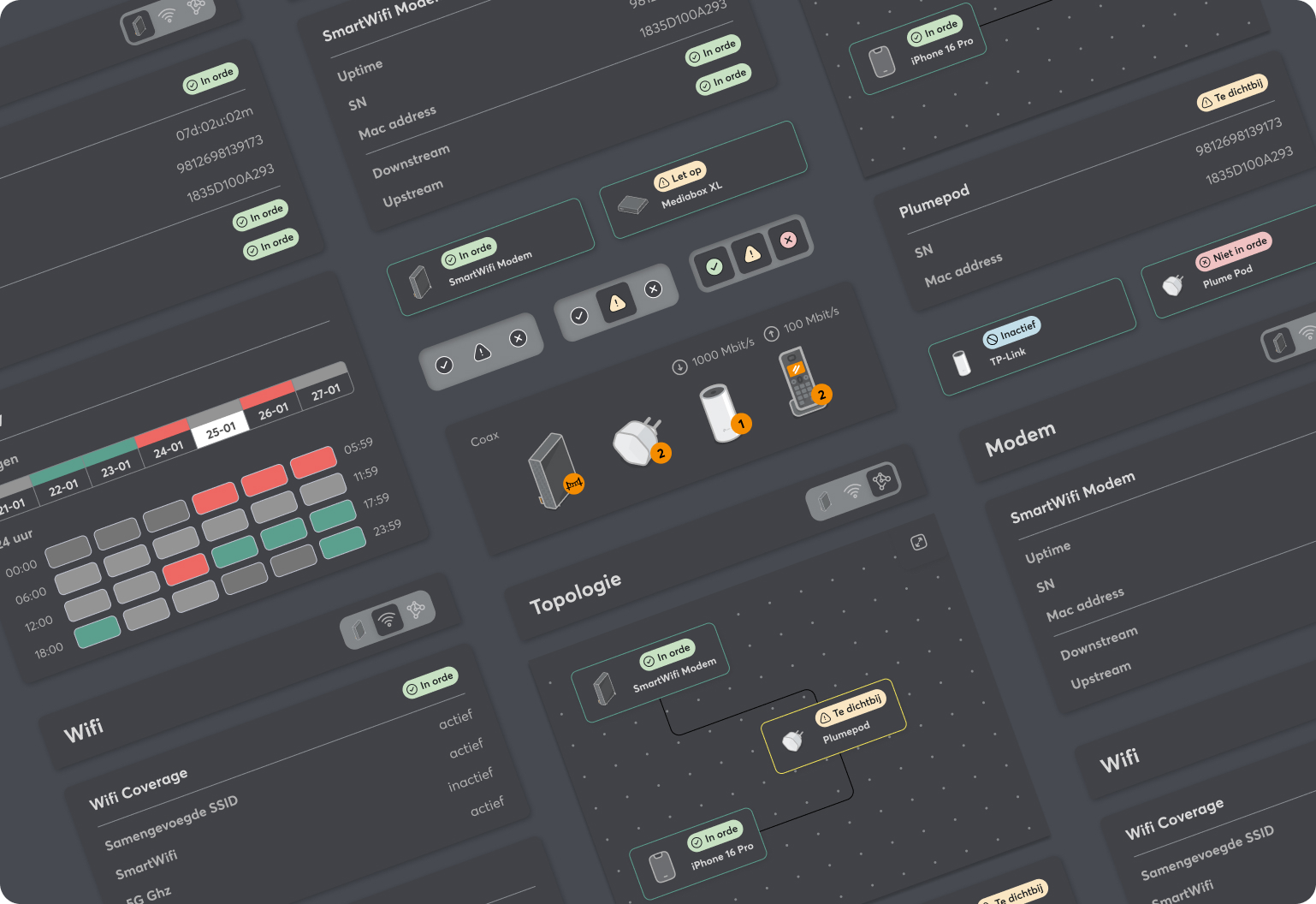
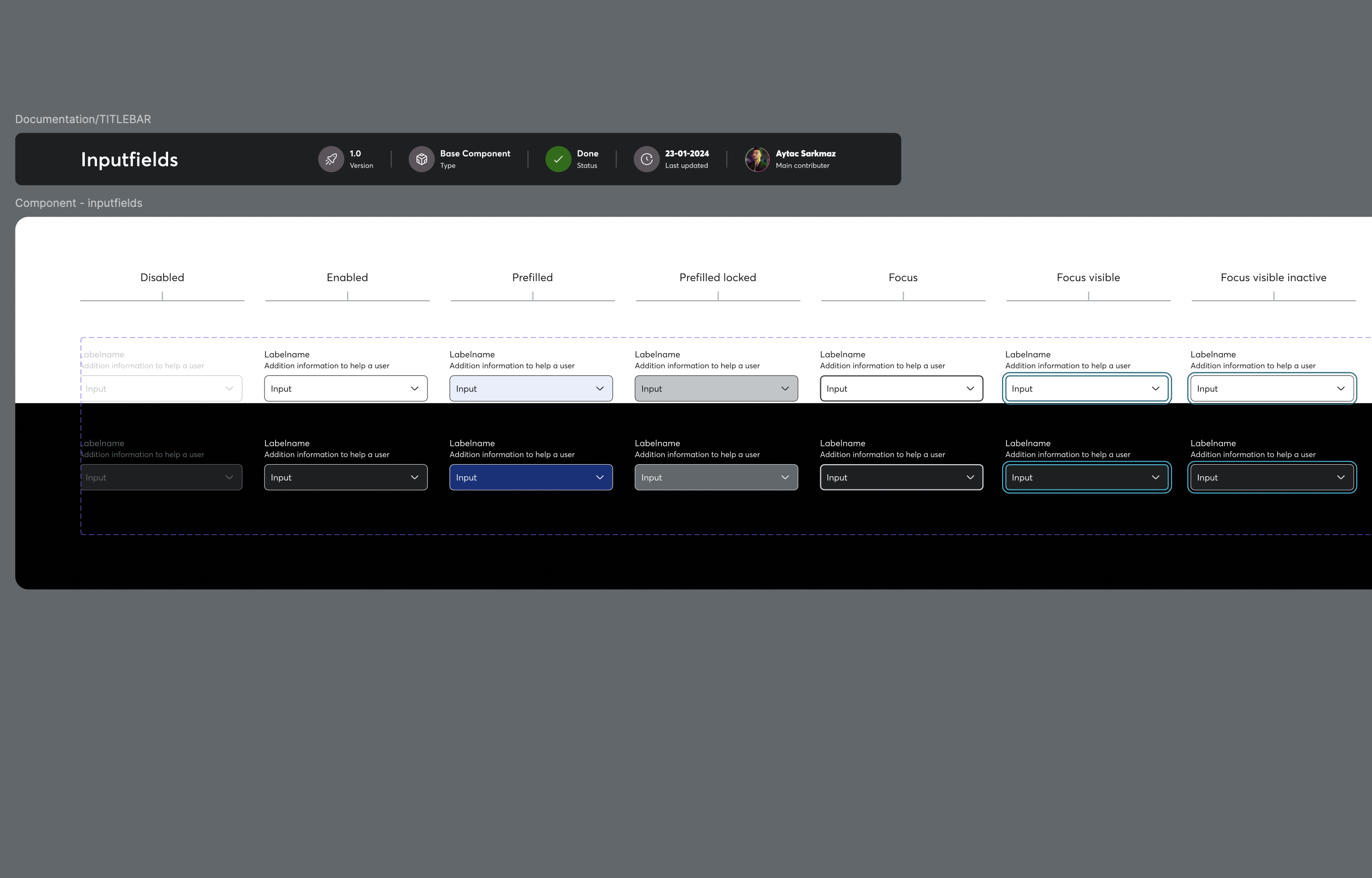
Design System Ownership
Developed and scaled a reusable internal design system adopted across all Employee Experience tools at VodafoneZiggo. Ensured accessibility (WCAG 2.1) for agents with visual/motor challenges. Delivered detailed, variant-rich components for seamless developer handoff, increasing consistency and reducing design/development time across platforms.
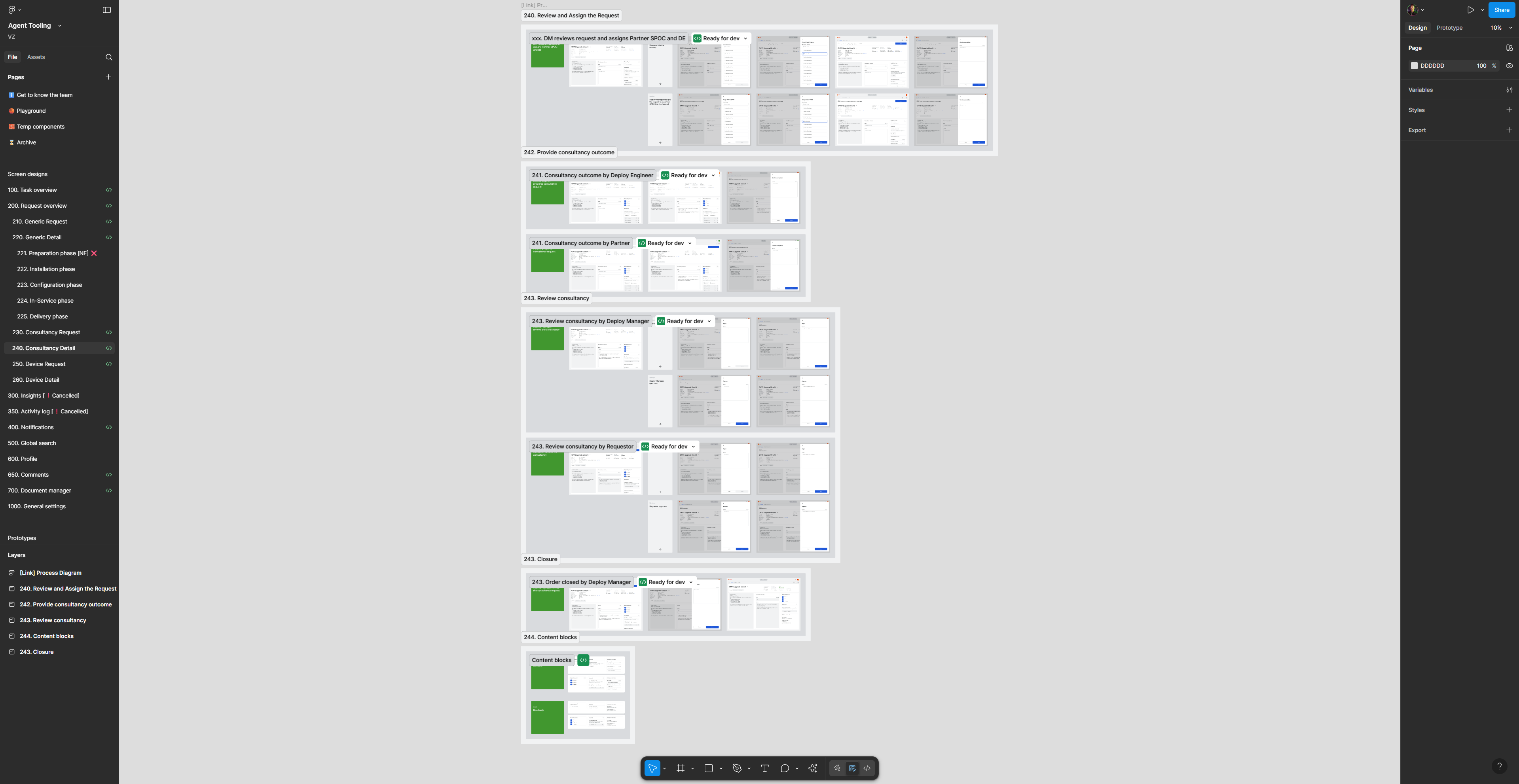
Results & Impact
- 70% faster resolution times
- Average call duration dropped from 30–45 minutes to 8–12 minutes
- +28% increase in Agent Satisfaction Score (internal survey)
- Estimated €1.2M annual cost savings due to shorter calls and fewer errors
- Estimation of +10 points NPS increase over a 12-month period after rollout
Strategic Thinking & Product Impact
- Collaborated with the PO to define MVP scope, aligned to business goals
- Contributed to the product roadmap, balancing short-term wins with long-term scalability
- Translated real agent needs into data-informed product decisions
Team Enablement & Leadership
- Mentored a junior designer on visual design and accessibility testing
- Helped non-design stakeholders (data engineers, devs) understand agent pain points through demo sessions and pain point identification sessions
- Help find a WOW for the team
Reflection
- This project taught me how to deliver high-impact work at the intersection of UX, product strategy, and engineering. It also validated the power of involving users early and often, especially when they’re the ones delivering value on the front lines.
- One of the key lessons came after our first co-creation session, where agents and team members expressed a strong desire for more data on the dashboard. As a team, we leaned into this request and initially tried to include as much data as possible. However, during usability testing, we quickly discovered that this approach led to visual overload and cognitive fatigue. The dashboard felt overwhelming, especially under time pressure.
- In hindsight, testing earlier with real API data would have helped us identify this complexity sooner. Based on the feedback, we redesigned the dashboard to be cleaner and calmer, surfacing only essential information upfront and tucking additional details behind specific pages.
- Another valuable insight came from a comment about eye strain. Agents are expected to use the tool for hours at a time, which led us to introduce a dark mode. Not just for aesthetic reasons, but to genuinely enhance comfort and accessibility for daily users. This helped us shift our focus even more toward long-term user well-being, not just functional UX.
- Designing this tool wasn't just about solving a technical or visual problem. It was about creating a system that supports people in their work, helps them perform with confidence, and acknowledges their real-world context.
Disclaimer
This case study uses fictional names and has been anonymized for privacy reasons. Some sections may include AI-assisted revisions for clarity.
Aytac
.design
Q2 2023 - Q2 2024
Transforming Internal Tooling for Thousands of Agents
Reducing handling time by 70% and creating a scalable UX foundation at VodafoneZiggo

Project Overview
At VodafoneZiggo, we redesigned the internal tool used by customer service agents, replacing an outdated legacy system (ADT) with a smart, user-centered platform that drastically improved efficiency, user satisfaction, and service quality.
The project goal: streamline workflows, reduce call handling time, and boost agent experience, ultimately impacting KPIs tied to operational cost and NPS.
The Challenge
Agents were using the outdated tool:
- Required ~30–50 clicks to resolve common issues
- No smart data integration despite available APIs
- Cluttered, non-accessible UI
- Long average call durations
- Poor agent morale and high training overhead
This inefficiency was costing the business in longer calls, lower CSAT/NPS, and higher support costs.
My Role
As Lead UX Designer, I owned the full process from discovery to final delivery, working in close collaboration with developers, data engineers, and product leadership.
I combined my background in software engineering and UX to:
- Translate technical API capabilities into smart UI flows
- Lead co-creation with users and stakeholders
- Align business, user, and technical needs
“In the old version, it took me 45 minutes. In the new one, just 5. I finally feel like I can focus on the customer again.”

Teun de Vries
SR Advisor OEC

Discovery & Research
I followed the Double Diamond and Design Thinking methods:
- Shadowed agents during live customer calls
- Conducted qualitative interviews to map pain points and desired improvements
- Performed the agent role myself for deeper empathy
- Synthesized insights into opportunity areas for automation, decision support, and layout simplification

Co-Creation & Ideation
I ran a series of design workshops with:
- Agents, to co-create ideas and highlight workflow needs
- Developers and data engineers, to explore feasibility
- Product Owners and Service Designers, to ensure alignment with roadmap and strategy
I facilitated prioritization sessions to scope features into an MVP and balance impact vs. effort.
I ran a series of design workshops with:
- Agents, to co-create ideas and highlight workflow needs
- Developers and data engineers, to explore feasibility
- Product Owners and Service Designers, to ensure alignment with roadmap and strategy
I facilitated prioritization sessions to scope features into an MVP and balance impact vs. effort.
“Test often test early.”
Wireframing
In the early concept phase, I began testing ideas through low-fidelity wireframes to map out the core user flows. These helped identify early friction points and align with stakeholders.

Paper Prototypes
I also created paper prototypes. This allowed agents and team members to interact with and critique the structure before any digital design was produced.

Low-Fidelity Design
Based on the findings from the paper prototypes and co-creation workshops, I translated validated ideas into low-fidelity designs in Figma.

Design Execution
Develop & Deliver
Modular, data-driven UI
- Created smart flows that react to real-time API data
- Reduced redundant inputs and manual searches
- Designed components to match service types dynamically
Prototyping & Testing
- Built interactive prototypes in Figma with conditional logic, micro-animations, and realistic flows
- Ran usability tests with 10+ agents, timing completion vs. old tool
- Iterated based on feedback loops after each sprint



Design System Ownership
Developed and scaled a reusable internal design system adopted across all Employee Experience tools at VodafoneZiggo. Ensured accessibility (WCAG 2.1) for agents with visual/motor challenges. Delivered detailed, variant-rich components for seamless developer handoff, increasing consistency and reducing design/development time across platforms.

Results & Impact
- 70% faster resolution times
- Average call duration dropped from 30–45 minutes to 8–12 minutes
- +28% increase in Agent Satisfaction Score (internal survey)
- Estimated €1.2M annual cost savings due to shorter calls and fewer errors
- Estimation of +10 points NPS increase over a 12-month period after rollout
Strategic Thinking & Product Impact
- Collaborated with the PO to define MVP scope, aligned to business goals
- Contributed to the product roadmap, balancing short-term wins with long-term scalability
- Translated real agent needs into data-informed product decisions
Team Enablement & Leadership
- Mentored a junior designer on visual design and accessibility testing
- Helped non-design stakeholders (data engineers, devs) understand agent pain points through demo sessions and pain point identification sessions
- Help find a WOW for the team
Reflection
- This project taught me how to deliver high-impact work at the intersection of UX, product strategy, and engineering. It also validated the power of involving users early and often, especially when they’re the ones delivering value on the front lines.
- One of the key lessons came after our first co-creation session, where agents and team members expressed a strong desire for more data on the dashboard. As a team, we leaned into this request and initially tried to include as much data as possible. However, during usability testing, we quickly discovered that this approach led to visual overload and cognitive fatigue. The dashboard felt overwhelming, especially under time pressure.
- In hindsight, testing earlier with real API data would have helped us identify this complexity sooner. Based on the feedback, we redesigned the dashboard to be cleaner and calmer, surfacing only essential information upfront and tucking additional details behind specific pages.
- Another valuable insight came from a comment about eye strain. Agents are expected to use the tool for hours at a time, which led us to introduce a dark mode. Not just for aesthetic reasons, but to genuinely enhance comfort and accessibility for daily users. This helped us shift our focus even more toward long-term user well-being, not just functional UX.
- Designing this tool wasn't just about solving a technical or visual problem. It was about creating a system that supports people in their work, helps them perform with confidence, and acknowledges their real-world context.
Disclaimer
This case study uses fictional names and has been anonymized for privacy reasons. Some sections may include AI-assisted revisions for clarity.
Aytac
.design
Q2 2023 - Q2 2024
Transforming Internal Tooling for Thousands of Agents
Reducing handling time by 70% and creating a scalable UX foundation at VodafoneZiggo

Project Overview
At VodafoneZiggo, we redesigned the internal tool used by customer service agents, replacing an outdated legacy system (ADT) with a smart, user-centered platform that drastically improved efficiency, user satisfaction, and service quality.
The project goal: streamline workflows, reduce call handling time, and boost agent experience, ultimately impacting KPIs tied to operational cost and NPS.
The Challenge
Agents were using the outdated tool:
- Required ~30–50 clicks to resolve common issues
- No smart data integration despite available APIs
- Cluttered, non-accessible UI
- Long average call durations
- Poor agent morale and high training overhead
This inefficiency was costing the business in longer calls, lower CSAT/NPS, and higher support costs.
My Role
As Lead UX Designer, I owned the full process from discovery to final delivery, working in close collaboration with developers, data engineers, and product leadership.
I combined my background in software engineering and UX to:
- Translate technical API capabilities into smart UI flows
- Lead co-creation with users and stakeholders
- Align business, user, and technical needs
“In the old version, it took me 45 minutes. In the new one, just 5. I finally feel like I can focus on the customer again.”

Teun de Vries
SR Advisor OEC
Discovery & Research
I followed the Double Diamond and Design Thinking methods:
- Shadowed agents during live customer calls
- Conducted qualitative interviews to map pain points and desired improvements
- Performed the agent role myself for deeper empathy
- Synthesized insights into opportunity areas for automation, decision support, and layout simplification


Co-Creation & Ideation
I ran a series of design workshops with:
- Agents, to co-create ideas and highlight workflow needs
- Developers and data engineers, to explore feasibility
- Product Owners and Service Designers, to ensure alignment with roadmap and strategy
I facilitated prioritization sessions to scope features into an MVP and balance impact vs. effort.
“Test often test early.”
Wireframing
In the early concept phase, I began testing ideas through low-fidelity wireframes to map out the core user flows. These helped identify early friction points and align with stakeholders.

Paper Prototypes
I also created paper prototypes. This allowed agents and team members to interact with and critique the structure before any digital design was produced.

Low-Fidelity Design
Based on the findings from the paper prototypes and co-creation workshops, I translated validated ideas into low-fidelity designs in Figma.

Design Execution
Develop & Deliver
Modular, data-driven UI
- Created smart flows that react to real-time API data
- Reduced redundant inputs and manual searches
- Designed components to match service types dynamically
Prototyping & Testing
- Built interactive prototypes in Figma with conditional logic, micro-animations, and realistic flows
- Ran usability tests with 10+ agents, timing completion vs. old tool
- Iterated based on feedback loops after each sprint


Design System Ownership
Developed and scaled a reusable internal design system adopted across all Employee Experience tools at VodafoneZiggo. Ensured accessibility (WCAG 2.1) for agents with visual/motor challenges. Delivered detailed, variant-rich components for seamless developer handoff, increasing consistency and reducing design/development time across platforms.


Results & Impact
- 70% faster resolution times
- Average call duration dropped from 30–45 minutes to 8–12 minutes
- +28% increase in Agent Satisfaction Score (internal survey)
- Estimated €1.2M annual cost savings due to shorter calls and fewer errors
- Estimation of +10 points NPS increase over a 12-month period after rollout
Strategic Thinking & Product Impact
- Collaborated with the PO to define MVP scope, aligned to business goals
- Contributed to the product roadmap, balancing short-term wins with long-term scalability
- Translated real agent needs into data-informed product decisions
Team Enablement & Leadership
- Mentored a junior designer on visual design and accessibility testing
- Helped non-design stakeholders (data engineers, devs) understand agent pain points through demo sessions and pain point identification sessions
- Help find a WOW for the team
Reflection
- This project taught me how to deliver high-impact work at the intersection of UX, product strategy, and engineering. It also validated the power of involving users early and often, especially when they’re the ones delivering value on the front lines.
- One of the key lessons came after our first co-creation session, where agents and team members expressed a strong desire for more data on the dashboard. As a team, we leaned into this request and initially tried to include as much data as possible. However, during usability testing, we quickly discovered that this approach led to visual overload and cognitive fatigue. The dashboard felt overwhelming, especially under time pressure.
- In hindsight, testing earlier with real API data would have helped us identify this complexity sooner. Based on the feedback, we redesigned the dashboard to be cleaner and calmer, surfacing only essential information upfront and tucking additional details behind specific pages.
- Another valuable insight came from a comment about eye strain. Agents are expected to use the tool for hours at a time, which led us to introduce a dark mode. Not just for aesthetic reasons, but to genuinely enhance comfort and accessibility for daily users. This helped us shift our focus even more toward long-term user well-being, not just functional UX.
- Designing this tool wasn't just about solving a technical or visual problem. It was about creating a system that supports people in their work, helps them perform with confidence, and acknowledges their real-world context.
Disclaimer
This case study uses fictional names and has been anonymized for privacy reasons. Some sections may include AI-assisted revisions for clarity.
